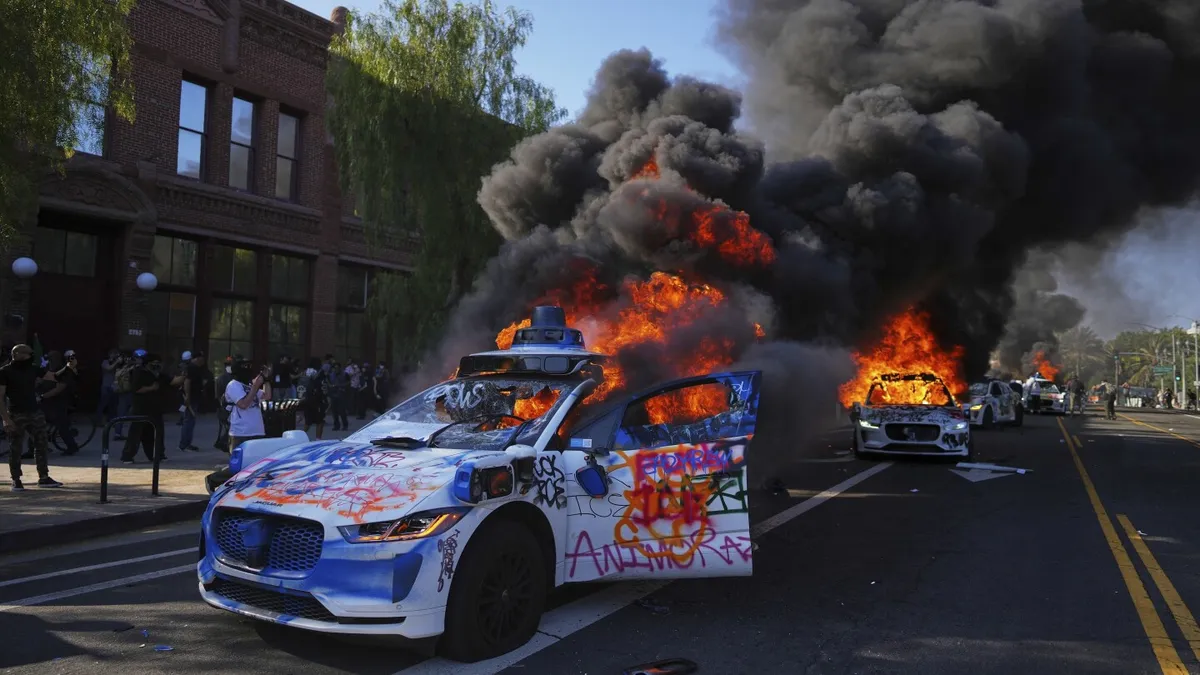
LOS ANGELES (AP) — Tensions reached a boiling point in Los Angeles on Sunday as thousands of protesters took to the streets in response to President Donald Trump’s controversial decision to deploy the National Guard. The demonstrations resulted in major disturbances, including the blocking of a major freeway and the destruction of self-driving vehicles. Law enforcement officials resorted to using tear gas, rubber bullets, and flash bangs in an attempt to control the escalating situation.
As evening approached, many protesters began to disperse after police declared an unlawful assembly, signaling imminent arrests for those who refused to leave. Residual protesters retaliated by throwing objects, including concrete chunks, rocks, electric scooters, and even fireworks at officers from the California Highway Patrol. The chaotic environment prompted officers to seek shelter under an overpass as they faced violence from behind makeshift barriers erected by the demonstrators.
These protests, taking place in downtown Los Angeles—a city home to over 4 million residents—marked the third consecutive day of fierce demonstrations against Trump’s immigration policies. The arrival of approximately 300 National Guard troops heightened the atmosphere of anger and fear among residents, particularly as these troops were deployed to safeguard federal buildings, including the downtown detention center where protests were most concentrated.
Los Angeles Police Chief Jim McDonnell described the situation as overwhelming, noting the presence of habitual agitators among the crowd who are known to incite trouble during demonstrations. Over the weekend, several dozen individuals were arrested, including one person charged with throwing a Molotov cocktail at police and another for ramming a motorcycle into a line of officers. Trump's response on social media was to urge McDonnell to arrest protesters wearing face masks, stating, “Looking really bad in L.A. BRING IN THE TROOPS!!!”
As the morning unfolded, National Guard troops lined up with long guns and riot shields, facing a crowd that shouted slogans like “shame” and “go home.” The situation quickly escalated when uniformed officers fired smoke-filled canisters to disperse the crowd. The Los Angeles Police Department then deployed crowd-control munitions, deeming the protesters' assembly unlawful. The protestors subsequently moved to obstruct traffic on the 101 freeway, leading to their eventual clearance by state patrol officers.
During these chaotic moments, at least four self-driving Waymo cars were set ablaze, creating large plumes of black smoke and intermittent explosions as the electric vehicles burned. By nightfall, police had issued an order for an unlawful assembly, effectively shutting down several blocks in downtown Los Angeles, with flash bangs ringing out repeatedly throughout the evening.
Democratic Governor Gavin Newsom expressed his discontent with the National Guard's deployment, labeling it a “serious breach of state sovereignty.” In a letter addressed to Trump on Sunday afternoon, Newsom emphasized that the troops' presence was unnecessary and potentially escalatory. He was in Los Angeles at the time, meeting with local law enforcement and officials to address the situation. Newsom, along with Los Angeles Mayor Karen Bass, criticized Trump's decision to send the National Guard, describing it as a provocative move intended to inflame tensions and disrupt the peace.
Both leaders urged protesters to maintain peaceful demonstrations, with Bass stating, “What we’re seeing in Los Angeles is chaos that is provoked by the administration. This is about another agenda; this isn’t about public safety.” In contrast, McDonnell argued that the protests followed a familiar pattern of civil unrest, intensifying as they progressed into their third day. He refuted claims from the Trump administration that the LAPD had failed to assist federal authorities during the protests that erupted following a series of immigration raids.
Newsom further asserted that California authorities had the situation under control, mocking Trump for his premature congratulatory messages to the Guard prior to their arrival. He characterized Trump as a “stone cold liar” during an interview on MSNBC. The administration, however, dismissed Newsom’s claims, with White House spokesperson Abigail Jackson stating, “It’s a bald-faced lie for Newsom to claim there was no problem in Los Angeles before President Trump got involved.”
The National Guard's deployment came after two days of intense protests that began on Friday in downtown Los Angeles, subsequently spreading to Paramount—a heavily Latino city south of the metropolis—and nearby Compton. Federal agents conducted arrests across various locations, including LA's fashion district and a Home Depot parking lot, which prompted protests fueled by fear of further immigration raids. Reports indicated that over 100 immigrants were arrested in the Los Angeles area during the week, with additional arrests made during the protests, including that of a prominent union leader accused of obstructing law enforcement.
While the protests were significant, they did not reach the scale of past demonstrations that prompted the National Guard's involvement in Los Angeles, such as the Watts riots, the Rodney King riots, and the 2020 protests against police violence. Historically, the last instance of National Guard activation without a governor's request occurred in 1965, during President Lyndon B. Johnson’s response to a civil rights march in Alabama, according to the Brennan Center for Justice.
In a directive issued Saturday, Trump invoked a legal provision allowing the deployment of federal service members in cases of “rebellion or danger of a rebellion against the authority of the Government of the United States.” He authorized the dispatch of 2,000 National Guard members, asserting that there were “violent people” in Los Angeles who “aren’t gonna get away with it.” When questioned about the potential deployment of U.S. troops to Los Angeles, Trump remarked, “We’re gonna have troops everywhere. We’re not going to let this happen to our country.” Reports indicated that around 500 Marines stationed at Twentynine Palms, approximately 125 miles east of Los Angeles, were in a “prepared to deploy status” on Sunday afternoon.
As the situation in Los Angeles continues to develop, both local authorities and federal officials remain on high alert, navigating the complexities of public safety, immigration policy, and civil unrest.